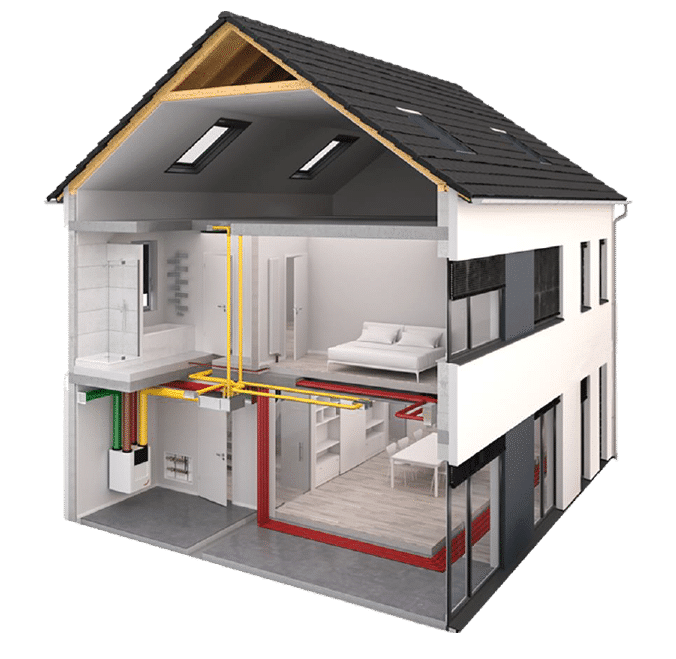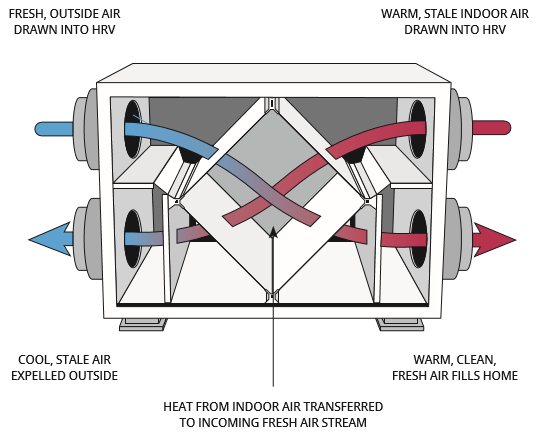How HRV Cuts Down Energy Bills Every Month
Wiki Article
Unveiling the Secret Advantages and Uses of Heat Recovery Ventilation in Lasting Design
Heat Recovery Ventilation (HRV) systems play an important duty in sustainable style. They help with a continuous exchange of stagnant indoor air with fresh outside air, considerably enhancing interior air top quality. Furthermore, HRVs add to energy effectiveness by reclaiming warm from worn down air, which can reduce energy prices. Recognizing the multifaceted advantages and applications of HRVs discloses their relevance in modern architecture. What various other advantages do these systems use in the quest of sustainability?Comprehending Heat Recovery Ventilation Solutions
Heat recovery ventilation (HRV) systems are created to boost interior air quality while reducing power loss. These systems use a mechanical air flow strategy to exchange stagnant indoor air with fresh exterior air, guaranteeing a continuous supply of tidy air. By recording heat from the exhaust air, HRVs prerequisite inbound air, lowering the need on home heating and cooling down systems. This process not just enhances thermal convenience however also adds to power efficiency in residential and business buildings. Furthermore, HRV systems aid manage humidity degrees and decrease indoor toxins, promoting a healthier living setting. Their tactical application is vital for attaining sustainable layout objectives, as they use a balance between energy preservation and passenger wellness.How HRV Systems Work
While several might know with air flow systems, comprehending just how warm recuperation air flow (HRV) systems operate is essential for appreciating their benefits. HRV systems function by exchanging stagnant indoor air with fresh outside air while moving warm in between the two streams. This process happens in a heat exchanger, where heat from the outward bound air heats the incoming air during chillier months, reducing energy loss. Alternatively, in warmer months, the system can cool down incoming air using the cooler outbound air. HRVs are furnished with followers to help with air movement and filters to eliminate particulates, making certain a continuous, well balanced air flow procedure. This cutting-edge layout not only improves power performance yet additionally adds to preserving a comfortable indoor atmosphere.Enhancing Indoor Air Quality
Indoor air high quality can considerably impact health and wellness, making reliable air flow crucial in modern-day homes. Heat Recovery Ventilation (HRV) systems play an essential function in keeping interior air high quality by constantly trading stale interior air with fresh outside air. This process not just reduces airborne contaminants yet also minimizes humidity degrees, which can cause mold growth and respiratory issues. HRV systems filter incoming air, removing allergens and particulates, consequently supplying a much healthier living environment. Furthermore, these systems aid remove odors and volatile organic substances (VOCs) generally located in house products. By making certain a regular circulation of tidy air, HRV systems add to a total improved indoor environment, advertising comfort and well-being for owners.Energy Efficiency and Expense Savings
Power effectiveness stands apart as a significant benefit of Heat Recovery Ventilation (HRV) systems. By capturing and recycling the heat from exhausted indoor air, HRVs minimize the power required for home heating incoming fresh air, leading to decreased energy intake. This performance equates right into lower energy bills, providing considerable expense financial savings for house owners and organizations alike. Furthermore, HRV systems often get power efficiency incentives and refunds, further improving their economic allure. Gradually, the initial investment in HRV modern technology can bring about a favorable return on financial investment with lowered energy costs. Subsequently, the combination of HRV systems not only advertises lasting layout yet likewise provides a functional service for attaining long-lasting power cost savings and economic benefits.Environmental Benefits of HRV

A wide range of ecological advantages develops from the application of Heat Recovery Ventilation (HRV) systems. By effectively transferring heat from exhaust air to incoming fresh air, HRVs substantially lower the energy required for home heating and cooling down rooms. This energy performance translates to reduce greenhouse gas emissions, contributing to a reduction in the general carbon footprint of buildings. Additionally, HRV systems improve interior air top quality by constantly flowing fresh air, thus decreasing the concentration of interior contaminants and allergens. Furthermore, the decrease in power intake aids in preserving natural sources, making HRVs an essential part of sustainable design. Generally, the ecological benefits of HRVs play a vital duty in promoting a much healthier earth and cultivating eco-friendly building methods.
Versatile Applications in Modern Style
Heat recovery ventilation (HRV) systems are significantly being integrated into both property and industrial building tasks. In residential settings, HRVs enhance indoor air top quality while making the most of power efficiency. In industrial rooms, these systems maximize air flow methods, demonstrating their convenience in modern-day building applications.Residential Projects Integration
While modern style increasingly emphasizes sustainability, the integration of warmth recuperation ventilation systems in household projects has actually emerged as a functional solution for enhancing indoor air top quality and energy effectiveness. These systems efficiently move heat from exhaust air to inbound fresh air, reducing power loss and minimizing heating or cooling down needs. In new builds and retrofits alike, warmth recuperation ventilation can be seamlessly incorporated, offering homeowners with a much healthier living atmosphere while lowering energy prices. Furthermore, with raising understanding of ecological influences, more architects and home builders are identifying the long-term benefits of these systems. Therefore, warm recovery air flow has actually become an important component of lasting household layout, showcasing flexibility and commitment to eco-friendly techniques.Industrial Spaces Optimization
As modern-day commercial areas advance to fulfill the needs of sustainability and performance, the execution of warm recuperation air flow systems emerges as a vital strategy for maximizing interior environments. These systems help with the exchange of stagnant indoor air with fresh exterior air while reclaiming heat, considerably minimizing power intake. This not just boosts convenience for owners yet also helps in reducing operational costs. Versatile applications can be observed in offices, retail areas, and universities, where air quality and temperature control are critical. Furthermore, integrating warmth recovery air flow straightens with environment-friendly building qualifications, better advertising ecological responsibility. Ultimately, taking on such systems in industrial style not only contributes to sustainability goals however additionally promotes healthier, extra productive areas for individuals.
Integrating HRV Into Sustainable Layout Practices
Integrating warmth recovery ventilation (HRV) systems into lasting style techniques provides substantial advantages in power performance and indoor air top quality. By making use of HRV, designers can develop affordable services that not just decrease power intake but additionally enhance the overall comfort of interior settings. This alignment with sustainability goals positions HRV as an important element in modern-day building techniques.
Power Effectiveness Improvement
By incorporating warmth recuperation air flow (HRV) systems right into lasting layout methods, designers and building contractors can significantly boost power efficiency in contemporary building and constructions. HRV systems operate by recording heat from outgoing stagnant air and moving it to incoming fresh air, lessening the power needed for home heating or cooling down indoor spaces. This procedure not HRV Heat Recovery Ventilation just decreases reliance on standard HVAC systems however also decreases total power usage. Additionally, HRV systems can help preserve a consistent interior temperature level, decreasing peak energy demands. By incorporating these systems, structures can attain considerable reductions in energy costs and carbon footprints, lining up with sustainability goals. Ultimately, HRV innovation represents a sensible option for improving power performance in the developed setting, advertising more responsible resource usage.Indoor Air Top Quality Renovation
Just how can heat healing air flow (HRV) systems add to premium indoor air high quality in modern-day buildings? HRV systems successfully exchange stagnant indoor air with fresh outside air while recuperating warm power, lessening temperature level variations. This process reduces the concentration of interior toxins, such as volatile organic compounds (VOCs), irritants, and dampness, which can wear away air top quality and influence passenger health and wellness. By keeping suitable humidity degrees and making sure a constant supply of tidy air, HRVs aid develop a much healthier indoor environment. Furthermore, these systems can be incorporated right into lasting layout practices, promoting power efficiency alongside boosted air high quality. HRV Heat Recovery Ventilation. Subsequently, HRV modern technology plays an essential duty in advancing general resident comfort and health in contemporary building layoutsCost-Effective Style Solutions

Often Asked Concerns
What Upkeep Is Needed for Heat Recovery Ventilation Equipments?

Maintenance for heat recuperation ventilation systems commonly entails regular filter substitutes, cleansing of warm exchangers, examination of followers and air ducts, and making sure appropriate drain. These jobs help maintain effectiveness and lengthen the system's life-span with time.
Can HRV Systems Be Mounted in Existing Buildings?
Heat recovery ventilation systems can certainly be installed in existing buildings. HRV Heat Recovery Ventilation. Retrofitting requires mindful planning and evaluation of the structure's design, making sure compatibility with present systems while making best use of power performance and indoor air qualityJust How Do HRV Equipment Impact Sound Levels Inside Your Home?
HRV systems can influence indoor sound levels by introducing audio from exterior sources via ventilation. Top quality installations frequently incorporate sound-dampening features, decreasing sound effect while supplying effective air exchange and keeping convenience indoors.Are There Any Kind Of Disadvantages to Making Use Of HRV Equipments?
The drawbacks of using HRV systems consist of prospective high initial expenses, upkeep obstacles, and the possibility of decreased indoor air high quality if filters are sporadically changed, which can cause concerns with humidity degrees.Just how Do I Pick the Right HRV System for My Demands?
Choosing the appropriate warm recovery air flow system involves reviewing specific demands, such as building dimension, environment, and energy effectiveness objectives. Additionally, examining system features, installation demands, and maintenance considerations is important for peak efficiency and satisfaction.Report this wiki page